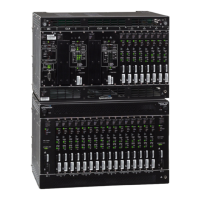222 TimeHub 5500 User’s Guide 097-55501-01 Revision M – January 2009
Chapter 5 Maintaining the TimeHub 5500
Troubleshooting the TimeHub 5500
Alarm (cont’d)
2. If the Output card contains FPGA
version B or later the Alarm LED
lights if there is a port alarm
detected. For details, see
Clearing
Output Port Alarms
, on page 206.
The current FPGA version appears
at the end of output card version
information in RTRV-NETYPE-ALL
response.
3. The Alarm LED lights if the Output
Driver card is using the Clock
signal from the standby clock.
While this is a perfectly good
clock to use, it should normally
use the clock signal from the
Active clock. If this is the cause of
the alarm, it could signify a
problem with the Active clock, the
backplane connection, or this
output card. If this is the cause of
the Alarm, the OSTBYCLK
(Output using STandBY CLocK)
event is generated.
See also Clearing Output Port
Alarms, on page 206.
Fail Off No hardware or firmware
failure has occurred on the
Output Driver card.
None required.
Red A hardware or firmware
failure has occurred on the
Output Driver card.
The Fail LED could be uniquely lit for
the following reasons:
1.
The card has an internal hardware
failure
.
2. The card has been initialized and
is not currently receiving a valid
clock signal. This can occur if
there are no Clock cards in the
shelf (or they are still in warmup):
the Fail LED on all Output Driver
cards in the shelf are lit.
3. If the Output Driver card contains
FPGA version A, the Fail LED
lights if a port alarm is detected.
To clear the alarm, see Clearing
Output Port Alarms, on page 206.
To check the firmware version,
see Reading the Output Driver
Firmware Version, on page 223.
Table 5-2. Troubleshooting the Output Driver Card Using Front Panel LEDs (Continued)
Name State Description Action

